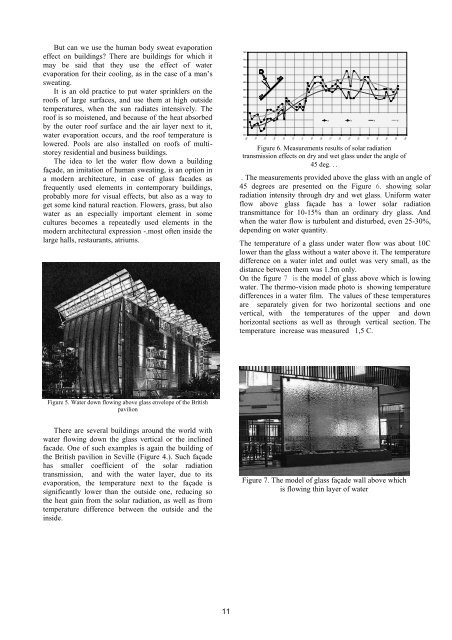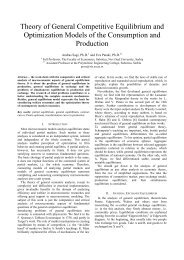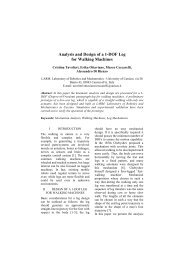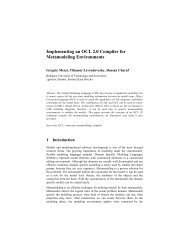air circulation in the summer, when the temperature ofinter-space should be as low as possible, in principleequal to the outside temperature. Or the openings maybe closed, which is the case during the winter, in orderto trap the air in the inter-space, which will act asinsulation layer, with the temperature above the outsidetemperature, producing lower heat losses of a building(Fig. 1.)Figure 1. Different double-facade constructions: continues(left) and discontinued (right)It is evident that during the heating period, cavitytemperature of a building with a double-façade is abovethe outside one, and will have lower heat losses anddecreased needs for heating. In the summer, during thecooling period, the temperature between the twofacades could be equal or very close to the outsidetemperature, and additionally can have smaller heatgains from solar radiation, depending on glassproperties regarding solar transmittance. As aconsequence, heat gains will not be above the gains ofa single façade buildings. During the summer, oneuses his conscious reactions for the additionalprotection of his body. He may protect himself by hats,or make a shade using a parasol. Similar protection isused in buildings by various curtains, shades, andVenetian blinds on windows, while today copies ofcaps and parasols are constructed, as immovableelements over roofs, or movable, depending on the suntemporary location. All those protections may be alsoused on facades.Examples of building protection from the solarradiation are numerous, especially in the regions oftropical conditions. An illustrative example is abuilding designed by the English architect Grindshawin Seville, built for the EXPO 1992. Movableprotection on the roof is put according to themomentary sun location, controlled by “building’sintelligence” (Fig. 3).VI. BUILDING’S EVAPORATIVE COOLINGFigure 2. The temperatures during the sunny day in JanuaryFigure 2. Shows the course of temperatures in the interspaceon an average sunny day in January, for theSouth-turned double facade, in Belgrade (45NL). Andthe figure 3. the cavity temperature in July summer dayDuring the summer, heat enters into buildings fromthe outside through hot air and solar radiation, but thereare also heat gains inside (lighting, domestic hot watersystems, people, electric appliances and devices). Suchheat must be eliminated so that the inside temperaturewould not be above the planned one, for example 22°C.In conditions when the outside temperature is abovethe human body temperature, the only way for a man toeliminate his inner heat is by perspiration, throughevaporation. A building cannot sweat, so that it has tobe cooled mechanically by air conditioning system.Figure 4. Solar “hats” on the roof of the British pavilion atEXPO 1992.Figure 3. Тhe cavity temperature in July summer day10
But can we use the human body sweat evaporationeffect on buildings? There are buildings for which itmay be said that they use the effect of waterevaporation for their cooling, as in the case of a man’ssweating.It is an old practice to put water sprinklers on theroofs of large surfaces, and use them at high outsidetemperatures, when the sun radiates intensively. Theroof is so moistened, and because of the heat absorbedby the outer roof surface and the air layer next to it,water evaporation occurs, and the roof temperature islowered. Pools are also installed on roofs of multistoreyresidential and business buildings.The idea to let the water flow down a buildingfaçade, an imitation of human sweating, is an option ina modern architecture, in case of glass facades asfrequently used elements in contemporary buildings,probably more for visual effects, but also as a way toget some kind natural reaction. Flowers, grass, but alsowater as an especially important element in somecultures becomes a repeatedly used elements in themodern architectural expression -.most often inside thelarge halls, restaurants, atriums.76074072070068066064062060058056054010:0410:1910:3310:4811:0211:1611:3111:4512:00a b c dFigure 6. Measurements results of solar radiationtransmission effects on dry and wet glass under the angle of45 deg. . .12:14. The measurements provided above the glass with an angle of45 degrees are presented on the Figure 6. showing solarradiation intensity through dry and wet glass. Uniform waterflow above glass façade has a lower solar radiationtransmittance for 10-15% than an ordinary dry glass. Andwhen the water flow is turbulent and disturbed, even 25-30%,depending on water quantity.The temperature of a glass under water flow was about 10Clower than the glass without a water above it. The temperaturedifference on a water inlet and outlet was very small, as thedistance between them was 1.5m only.On the figure 7 is the model of glass above which is lowingwater. The thermo-vision made photo is showing temperaturedifferences in a water film. The values of these temperaturesare separately given for two horizontal sections and onevertical, with the temperatures of the upper and downhorizontal sections as well as through vertical section. Thetemperature increase was measured 1,5 C.12:2812:4312:5713:1213:2613:4013:5514:09Figure 5. Water down flowing above glass envelope of the BritishpavilionThere are several buildings around the world withwater flowing down the glass vertical or the inclinedfacade. One of such examples is again the building ofthe British pavilion in Seville (Figure 4.). Such façadehas smaller coefficient of the solar radiationtransmission, and with the water layer, due to itsevaporation, the temperature next to the façade issignificantly lower than the outside one, reducing sothe heat gain from the solar radiation, as well as fromtemperature difference between the outside and theinside.Figure 7. The model of glass façade wall above whichis flowing thin layer of water11
- Page 1 and 2: 4 4 th IEEE International Symposium
- Page 3 and 4: EXPRES 20124 th International Sympo
- Page 5 and 6: Application of Thermopile Technolog
- Page 7 and 8: Design of a Solar Hybrid System....
- Page 9 and 10: ___________________________________
- Page 11: environmental protection and global
- Page 15 and 16: IX. REFERENCES[1] Todorovic B. Cvje
- Page 17 and 18: QQ⎛ Λt⎞=⎜⎟⎝ Λ ⎠Nt Nwh
- Page 19 and 20: Analysis of the Energy-Optimum of H
- Page 21 and 22: V. OBJECTIVE FUNCTIONThe objective
- Page 23 and 24: The Set-Up Geometry of Sun Collecto
- Page 25 and 26: continuous east-west sun collector
- Page 27 and 28: continuously measure the thermal ch
- Page 29 and 30: CEvaluation of measurement resultsA
- Page 31 and 32: Application of Thermopile Technolog
- Page 33 and 34: Temperature of the components [C]90
- Page 35 and 36: nighttime, to weather or to the cha
- Page 37 and 38: η uη u0.50.40.30.20.1T 1 - 400K0.
- Page 39 and 40: Figure 10. . SPS Concept illustrati
- Page 41 and 42: [16] Zoya B. Popović: Wireless Pow
- Page 43 and 44: 25.0020.0015.0010.005.000.00Figure
- Page 45 and 46: · ℃ 0.0738 · 1.209 0.0892
- Page 47 and 48: use may be advantageous not only in
- Page 49 and 50: To find the reasons for this disagr
- Page 51 and 52: Toward Future: Positive Net-Energy
- Page 53 and 54: EnergyPlus environment, we used mod
- Page 55 and 56: To keep future energy consumption d
- Page 57 and 58: A New Calculation Method to Analyse
- Page 59 and 60: On Fig. 3. can be seen the areas th
- Page 61 and 62: Present and Future of Geothermal En
- Page 63 and 64:
TABLE II.THE TEMPERATURE DATA AND C
- Page 65 and 66:
Error in Water Meter Measuring at W
- Page 67 and 68:
III.RESULTS OF MEASURMENTSEach meas
- Page 69 and 70:
TABLE I.THE AVERAGE VALUE OF THERMA
- Page 71 and 72:
If the walls of the DHEs are made o
- Page 73 and 74:
Environmental External Costs Associ
- Page 75 and 76:
iodiesel production facility with a
- Page 77 and 78:
Contribution of unit processesto ex
- Page 79 and 80:
Heat Pump News in HungaryBéla Ád
- Page 81 and 82:
Thermal Comfort Measurements In Lar
- Page 83 and 84:
IV.DISCUSSIONThe sample frequencies
- Page 85 and 86:
For a Clear View of Traditional and
- Page 87 and 88:
esults in geographically distribute
- Page 89 and 90:
Design of a Solar Hybrid SystemMari
- Page 91 and 92:
Maintaining the set point temperatu
- Page 93 and 94:
Decision system theory model of ope
- Page 95 and 96:
parameter of pump in the function o
- Page 97 and 98:
Importance and Value of Predictive
- Page 99 and 100:
D. Overview of existing boiler oper
- Page 101 and 102:
HEAVY FUEL OIL FIRED, STEAMNATURAL
- Page 103 and 104:
MATHEMATICAL MODEL AND NUMERICAL SI
- Page 105 and 106:
C. Energy balance equationMathemati
- Page 107 and 108:
Discretization energy balance equat
- Page 109 and 110:
T ulf=32 º C, A - m =0.00162 kg/s,
- Page 111 and 112:
Comparison of Heat Pump and MicroCH
- Page 113 and 114:
the microCHP development. The energ
- Page 115 and 116:
control and stabilizer must be deve
- Page 117 and 118:
In Figure 1, in relation to the ord
- Page 119 and 120:
NPCC BHXOBYNI x1I x2I x3I x4LO YKYO
- Page 121 and 122:
exchange, as in reality, economies
- Page 123 and 124:
esponsibilities for consequences, o
- Page 125 and 126:
Coca-Cola Enterprise Inc had approx
- Page 127 and 128:
Flow Pattern Map for In Tube Evapor
- Page 129 and 130:
circumference with a liquid film. T
- Page 131 and 132:
Tube diameter: d 6 mm W Heat flux
- Page 133 and 134:
Realization of Concurrent Programmi
- Page 135 and 136:
applications the development, optim
- Page 137 and 138:
Renewable energy sources in automob
- Page 139 and 140:
commercial arrays can be built at b
- Page 141 and 142:
of multiple thin films produced usi
- Page 143:
EXPRES 20124 th International Sympo












